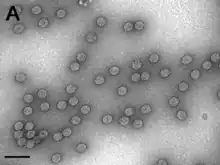| Caulimovirus | |
|---|---|
 | |
| TEM micrograph of CaMV virions bar scale equals 100 nm | |
| Virus classification | |
| (unranked): | Virus |
| Realm: | Riboviria |
| Kingdom: | Pararnavirae |
| Phylum: | Artverviricota |
| Class: | Revtraviricetes |
| Order: | Ortervirales |
| Family: | Caulimoviridae |
| Genus: | Caulimovirus |
Caulimovirus is a genus of viruses, in the family Caulimoviridae order Ortervirales. Plants serve as natural hosts. There are 12 species in this genus. Diseases associated with this genus include: vein-clearing or banding mosaic.[1][2]
Taxonomy
The genus contains the following species:[2]
- Angelica bushy stunt virus
- Atractylodes mild mottle virus
- Carnation etched ring virus
- Cauliflower mosaic virus
- Dahlia mosaic virus
- Figwort mosaic virus
- Horseradish latent virus
- Lamium leaf distortion virus
- Mirabilis mosaic virus
- Soybean Putnam virus
- Strawberry vein banding virus
- Thistle mottle virus
Structure
Viruses in Caulimovirus are non-enveloped, with icosahedral geometries, and T=7, T=7 symmetry. The diameter is around 50 nm. Genomes are circular and non-segmented. The genome codes for 6 to 7 proteins.[1]
| Genus | Structure | Symmetry | Capsid | Genomic arrangement | Genomic segmentation |
|---|---|---|---|---|---|
| Caulimovirus | Icosahedral | T=7 | Non-enveloped | Circular | Monopartite |
Life cycle
Viral replication is nuclear/cytoplasmic. Entry into the host cell is achieved by attachment of the viral proteins to host receptors, which mediates endocytosis. Replication follows the dsDNA-RT replication model. DNA-templated transcription, specifically dsDNA-RT transcription is the method of transcription. Translation takes place by ribosomal shunting. The virus exits the host cell by nuclear pore export, and tubule-guided viral movement. Plants serve as the natural host. The virus is transmitted via a vector (aphid insects). Transmission routes are mechanical.[1]
| Genus | Host details | Tissue tropism | Entry details | Release details | Replication site | Assembly site | Transmission |
|---|---|---|---|---|---|---|---|
| Caulimovirus | Plants | None | Viral movement; mechanical inoculation | Viral movement | Nucleus | Cytoplasm | Mechanical inoculation: aphids |
References
- 1 2 3 "Viral Zone". ExPASy. Retrieved 15 June 2015.
- 1 2 "Virus Taxonomy: 2020 Release". International Committee on Taxonomy of Viruses (ICTV). March 2021. Retrieved 21 May 2021.